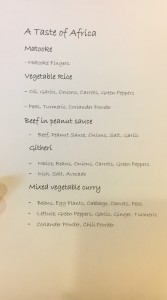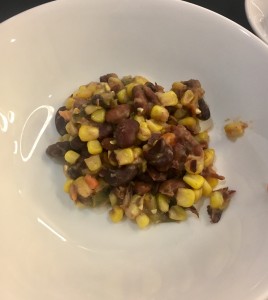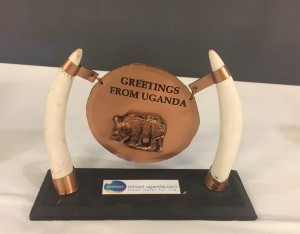A Taste of Uganda
 On Monday, April 8th, the Department of Student Activities presented A Taste of Uganda, an event where students were able to experience some traditional delicacies of this African country during a three course meal. There was a liaison, John Ochieng , with Frostburg’s satellite school, the Water School, which is in Uganda. John spoke about each dish that was presented and helped Chartwells prepare these traditional dishes to keep them as authentic as can be.
On Monday, April 8th, the Department of Student Activities presented A Taste of Uganda, an event where students were able to experience some traditional delicacies of this African country during a three course meal. There was a liaison, John Ochieng , with Frostburg’s satellite school, the Water School, which is in Uganda. John spoke about each dish that was presented and helped Chartwells prepare these traditional dishes to keep them as authentic as can be.
The first dish served was Matooke, traditionally made with green bananas and presented with peanut sauce along with a type of bean, fish, or meat. For this dinner, the green bananas were substituted for plantains, and served with beef in peanut sauce. Many in the room thoroughly enjoyed such a dish, comparing the mashed plantains to potatoes and commenting on how well the peanut taste complimented that of the plantains.
Before the next course, John spoke a bit about the Water School, explaining that he has had a relationship with the university for eight years, previously having Frostburg students go to Uganda every year to assist with the school, as well. The satellite school itself focuses on helping families find safe and clean water, as outside of Uganda water access is extremely limited. Uganda itself is lucky to be located right along the banks of Lake Victoria, the beginning of the Nile River, thus allowing for crops to grow and water access to those who are close to it.
The second dish served was a vegetable curry with vegetable rice, showing influence from Indian culture and using many different spices. Some thought it was hot, others thought it wasn’t hot enough. Traditionally the dish would be served with spices sitting on the table so one could season their food as desired, but there was a limit to how far the authenticity would go.
Due to the fact that Uganda is sitting on the banks of a lake, agriculture is a quarter of the country’s GDP, allowing for fresh vegetables and fruits to cook with. John explained that it is a very American idea that meals should be different each day, a sandwich today and a burger tomorrow, not repeating meals extremely often. However, in Uganda, you cook with what you have. If you just harvested green bananas, then Matooke might be the meal for the coming days or weeks. They are not as focused on eating as many other cultures are. In Uganda, meals are cooked with whatever fruits and veggies are fresh.
The last traditional course of the meal, Githerí, was a dish of maize and beans boiled together and served with fresh avocado. Many at the event were commenting on how fresh and healthy everything tasted, especially in comparison to fast food and common foods in the U.S. To end the dinner, Adam, the head chef at Chartwells, prepared banana cream pie, not traditional Uganadan food, but nonetheless delicious. A traditional Ugandan dessert is usually made of fresh or dried fruits with peanuts and sugar cane juice, very simple. To end the night, Dr. Nowacyzk and Dr. Bowling presented John with a gift for hosting such an event on his last day at Frostburg and sharing his culture with staff and students.






